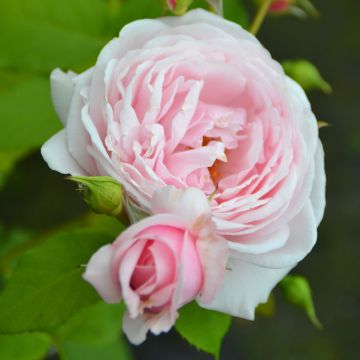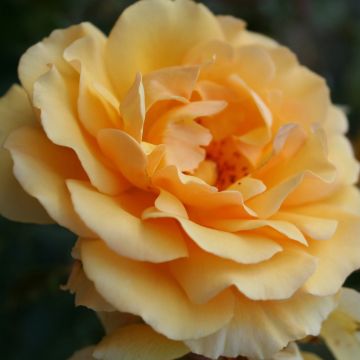

Rosa Queen Elizabeth - Standard Floribunda Rose
Rosa Queen Elizabeth - Standard Floribunda Rose
Rosa Queen Elisabeth
Rose
Special offer!
Receive a €20 voucher for any order over €90 (excluding delivery costs, credit notes, and plastic-free options)!
1- Add your favorite plants to your cart.
2- Once you have reached €90, confirm your order (you can even choose the delivery date!).
3- As soon as your order is shipped, you will receive an email containing your voucher code, valid for 3 months (90 days).
Your voucher is unique and can only be used once, for any order with a minimum value of €20, excluding delivery costs.
Can be combined with other current offers, non-divisible and non-refundable.
Home or relay delivery (depending on size and destination)
Schedule delivery date,
and select date in basket
We guarantee the quality of our plants for a full growing cycle, and will replace at our expense any plant that fails to recover under normal climatic and planting conditions.
Description
The standard version of the 'Queen Elizabeth' hybrid tea rose is a timeless classic. This variety owes its popularity to the elegance of its large, perfectly shaped roses in a very pure light pink colour. While it has been planted in gardens en masse since its creation in 1954, its vigour and continuous flowering from June to October also contribute to its appeal. Despite being criticised for its stiff habit, it still produces long, sturdy stems that are ideal for long-lasting bouquets. This standard rose deserves a prominent place in the centre of a rose bed, for example.
Standard roses are obtained by grafting a variety (in this case, Queen Elizabeth) onto a single, upright stem belonging to a different rose (Rosa canina, R. laxa or R. multiflora). The graft is made at a certain height, here at 90 cm (35in) - 1 m (3ft) from the ground. In very cold regions, it may be necessary to protect the rootstock in winter.
The Queen Elizabeth Hybrid Tea Rose, introduced in 1954 by Dr. Walter E. Lammerts (USA), is one of the modern hybrid tea roses belonging to the 'grandiflora' group. Obtained by crossing hybrid teas with floribundas, they are as floriferous as the latter and display the perfect beauty of the former. This variety was awarded an AARS in the USA in 1955, the most prestigious award guaranteeing the quality of a rose after 2 years of testing in all climates. More recently, in 2015, it received an Award of Excellence for Best Established Rose, also in the United States.
As a standard rose, Queen Elizabeth has the characteristic habit of a small tree, with a slightly stiff and sometimes irregular crown. Its robust branches bear large prickles and medium green, glossy foliage that can be susceptible to diseases. It is not uncommon for some of its stems to reach a height of 2 m (7ft). This continuously flowering rose blooms from June to October. It produces solitary or clusters of 3 or 4 roses at the end of very straight stems. Turbinate in shape, measuring 10 to 12 cm (4 to 5in) across, they are composed of 26 to 40 well-arranged petals. Their colour is a medium intensity pure pink, and very fresh. These flowers are scentless.
Although it can be somewhat challenging to integrate into a flower bed due to its unnatural habit, the Queen Elizabeth Standard Rose is adaptable to poor soil and difficult conditions. This rose will find its place in the centre of a large rose bed, as a standalone feature in a well-maintained garden, in a row along a pathway, or even in a container on the patio. Throughout the summer season, it offers abundant flowers that can be used to create lovely bouquets. In a classic and tasteful bouquet, their perfect form can be complemented by forget-me-nots, catmints, foxgloves, peach-leaved bellflowers, and clouds of pink or white baby's breath.
Report an error about the product description
Plant habit
Flowering
Foliage
Botanical data
Rosa
Queen Elisabeth
Rosaceae
Rose
Cultivar or hybrid
Planting and care
To plant your Queen Elizabeth Standard Rose, prepare your soil by loosening it to a depth of 40 cm (15.8in) and add a bottom amendment such as bonemeal. Position your plant, covering the top of the root ball with 3 cm (1in) of soil, then fill in the hole and water thoroughly to eliminate any air pockets. During dry weather, it is important to water regularly for a few weeks to encourage root growth. Don't forget to apply a special rose fertiliser to your standard rose to encourage flowering.
In regions with very cold winters, it is advisable to protect the graft of standard roses (the "trunk") by wrapping it with a thick winter covering.
Planting period
Intended location
Care
This item has not been reviewed yet - be the first to leave a review about it.
Similar products
Haven't found what you were looking for?
Hardiness is the lowest winter temperature a plant can endure without suffering serious damage or even dying. However, hardiness is affected by location (a sheltered area, such as a patio), protection (winter cover) and soil type (hardiness is improved by well-drained soil).

Photo Sharing Terms & Conditions
In order to encourage gardeners to interact and share their experiences, Promesse de fleurs offers various media enabling content to be uploaded onto its Site - in particular via the ‘Photo sharing’ module.
The User agrees to refrain from:
- Posting any content that is illegal, prejudicial, insulting, racist, inciteful to hatred, revisionist, contrary to public decency, that infringes on privacy or on the privacy rights of third parties, in particular the publicity rights of persons and goods, intellectual property rights, or the right to privacy.
- Submitting content on behalf of a third party;
- Impersonate the identity of a third party and/or publish any personal information about a third party;
In general, the User undertakes to refrain from any unethical behaviour.
All Content (in particular text, comments, files, images, photos, videos, creative works, etc.), which may be subject to property or intellectual property rights, image or other private rights, shall remain the property of the User, subject to the limited rights granted by the terms of the licence granted by Promesse de fleurs as stated below. Users are at liberty to publish or not to publish such Content on the Site, notably via the ‘Photo Sharing’ facility, and accept that this Content shall be made public and freely accessible, notably on the Internet.
Users further acknowledge, undertake to have ,and guarantee that they hold all necessary rights and permissions to publish such material on the Site, in particular with regard to the legislation in force pertaining to any privacy, property, intellectual property, image, or contractual rights, or rights of any other nature. By publishing such Content on the Site, Users acknowledge accepting full liability as publishers of the Content within the meaning of the law, and grant Promesse de fleurs, free of charge, an inclusive, worldwide licence for the said Content for the entire duration of its publication, including all reproduction, representation, up/downloading, displaying, performing, transmission, and storage rights.
Users also grant permission for their name to be linked to the Content and accept that this link may not always be made available.
By engaging in posting material, Users consent to their Content becoming automatically accessible on the Internet, in particular on other sites and/or blogs and/or web pages of the Promesse de fleurs site, including in particular social pages and the Promesse de fleurs catalogue.
Users may secure the removal of entrusted content free of charge by issuing a simple request via our contact form.
The flowering period indicated on our website applies to countries and regions located in USDA zone 8 (France, the United Kingdom, Ireland, the Netherlands, etc.)
It will vary according to where you live:
- In zones 9 to 10 (Italy, Spain, Greece, etc.), flowering will occur about 2 to 4 weeks earlier.
- In zones 6 to 7 (Germany, Poland, Slovenia, and lower mountainous regions), flowering will be delayed by 2 to 3 weeks.
- In zone 5 (Central Europe, Scandinavia), blooming will be delayed by 3 to 5 weeks.
In temperate climates, pruning of spring-flowering shrubs (forsythia, spireas, etc.) should be done just after flowering.
Pruning of summer-flowering shrubs (Indian Lilac, Perovskia, etc.) can be done in winter or spring.
In cold regions as well as with frost-sensitive plants, avoid pruning too early when severe frosts may still occur.
The planting period indicated on our website applies to countries and regions located in USDA zone 8 (France, United Kingdom, Ireland, Netherlands).
It will vary according to where you live:
- In Mediterranean zones (Marseille, Madrid, Milan, etc.), autumn and winter are the best planting periods.
- In continental zones (Strasbourg, Munich, Vienna, etc.), delay planting by 2 to 3 weeks in spring and bring it forward by 2 to 4 weeks in autumn.
- In mountainous regions (the Alps, Pyrenees, Carpathians, etc.), it is best to plant in late spring (May-June) or late summer (August-September).
The harvesting period indicated on our website applies to countries and regions in USDA zone 8 (France, England, Ireland, the Netherlands).
In colder areas (Scandinavia, Poland, Austria...) fruit and vegetable harvests are likely to be delayed by 3-4 weeks.
In warmer areas (Italy, Spain, Greece, etc.), harvesting will probably take place earlier, depending on weather conditions.
The sowing periods indicated on our website apply to countries and regions within USDA Zone 8 (France, UK, Ireland, Netherlands).
In colder areas (Scandinavia, Poland, Austria...), delay any outdoor sowing by 3-4 weeks, or sow under glass.
In warmer climes (Italy, Spain, Greece, etc.), bring outdoor sowing forward by a few weeks.








































